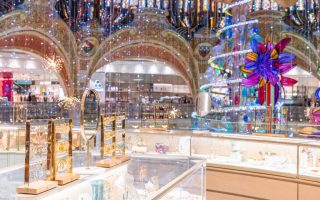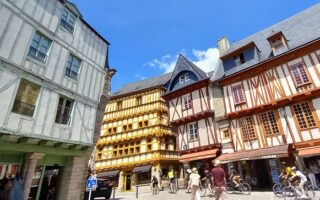Long Live the Queen

The blockbuster exhibit at the Grand Palais is just one example of Marie Antoinette mania in France. The doomed 18th-century queen had already become a 21st-century fashion icon as the muse of Dior’s spring/summer 2006 couture collection, and then director Sofia Coppola reinvented her in a rock’n’roll version for the glam-pop movie (loosely) based on Antonia Fraser’s best-selling biography. Could merchandising mania be far behind?
During the exhibit, the Grand Palais gift shop is offering Marie Antoinette trinkets ranging from pretty pink refrigerator magnets and monogrammed dish towels to jewelry, silk scarves, an adorable taffeta princess dress (ages 4-10) and an elegant porcelain tea service inspired by one made for the queen’s travel case (now at the Louvre). Also at the Grand Palais during the exhibit are Secrets de Famille, recreations of two 18th-century aperitif wines originally produced by Jean Orliac, who was pardoned out of debtor’s prison by Louis XVI. Sisters Catherine and Isabelle Orliac, the winemaker’s descendants, found the original copy of the king’s pardon, along with recipes for the wines-the king, it seems, preferred Orliac’s fruit-laced red, while the queen liked the ginger-and-rose-flavored white. (Much of the Marie Antoinette collection will be permanently available at national museum shops.)
At the Grand Palais, and also at the Château de Versailles, is the limited edition perfume Sillage de la Reine. While working on a biography of Marie Antoinette’s perfumer and glove-maker Jean-Louis Fargeon, historian Elisabeth de Feydeau discovered authentic formulas Fargeon used for the queen’s fragrances. She contacted leading French “nose” Francis Kurkdjian and together they poured over Fargeon’s notes, paying frequent visits to the queen’s dressing rooms and the scented gardens of the Petit Trianon. The original perfumes would have been fruity and flowery but cloyingly heavy, so Kurkdjian adapted his formula for modern tastes, still using only natural ingredients. The result is an intensely floral essence of jasmine, orange blossom, tuberose, iris, amber and sandalwood, packaged in a Baccarat crystal bottle. Sillage (a scented wake left in the air) is a rather ironic name, however, given the popular story that, as the royal family fled Versailles in disguise, their carriage was stopped because the unwashed rabble was tipped off by the fragrant odors wafting from it.
Luxury Swiss watchmaker Breguet also has historical links with MA. Founder Abraham Louis Breguet made a unique gold pocket watch for the queen using all the known clock-making complications of the time. Commissioned in 1783 by a secret admirer of the queen, the watch was not finished until 1827, 34 years after her death on the scaffold. Breguet has now produced an identical copy of the watch, along with a Marie Antoinette jewelry collection including earrings that cascade in glittering spirals of pink sapphires and rubies, designed to sway like the famous red currant bushes in the Petit Trianon gardens. Other pieces inspired by the Orangerie at Versailles are set with incandescent red and orange bouquets of garnets, pink tourmalines, spinels, rubies and yellow beryl. The centerpiece of the collection-literally worth a queen’s ransom-is an exclusive made-to-order white gold wristwatch bedecked with 1,160 diamonds and 340 pink sapphires.
Inspired by another historical anecdote, porcelain manufacturer Bernardaud offers reproductions of three pieces from the Rambouillet Dairy service. In 1783, Louis XVI bought the Château de Rambouillet for its extensive hunting grounds. But his young wife didn’t share his passion for hunting and found the medieval castle gloomy and old-fashioned. Hoping to win her over, Louis secretly ordered a dairy farm added, where his spouse could play milkmaid. The queen never got to use the Laiterie or the famous Rambouillet Dairy service Louis commissioned from Sèvres, but Bernardaud clients can snap up goblets decorated with pastoral idylls, cows, sheep and goats, or an exquisite “jatte-téton“, a small porcelain bowl mounted on a tripod of miniature goats’ hooves. Legend says the original bowl (now in the National Ceramic Museum at Sèvres) was molded on the queen’s breast.
Fabric designer Pierre Frey provided the Coppola film with sumptuous materials including “Papillons“, depicting bucolic scenes of butterflies and flowers, now available in Frey’s Paris shops. Although pastry shop Ladurée’s macarons also featured prominently in the film, those pastel-colored confections were not actually around in the queen’s day. For a slightly more authentic experience, try Marie Antoinette’s favorite dark chocolate pistoles made by Debauve & Gallais, a chocolatier opened in 1800 by Louis XVI’s former pharmacist. And for royal treatment at regal prices, the Hôtel George V spa offers a Marie Antoinette session with a milky facial and an orange-blossom body scrub.
RMN (National museums) boutique 49 rue Etienne Marcel, 1st, 01.40.13.49.12. website
Breguet 6 pl Vendôme, 1st, 01.47.03.65.00
Bernardaud 11 rue Royale, 8th, 01.47.42.82.66
Pierre Frey 2 bis rue de Furstenberg, 6th, 01.46.33.73.00
Ladurée 16 rue Royale, 8th, 01.42.60.21.79
Debauve & Gallais 30 rue des Saints Pères, 7th, 01.45.48.54.67
Hôtel George V 31 ave George V, 8th, 01.49.52.70.00
See our complete Paris shopping guide
View Long Live the Queen in a larger map
Share to: Facebook Twitter LinkedIn Email
Leave a reply
Your email address will not be published. Required fields are marked *



